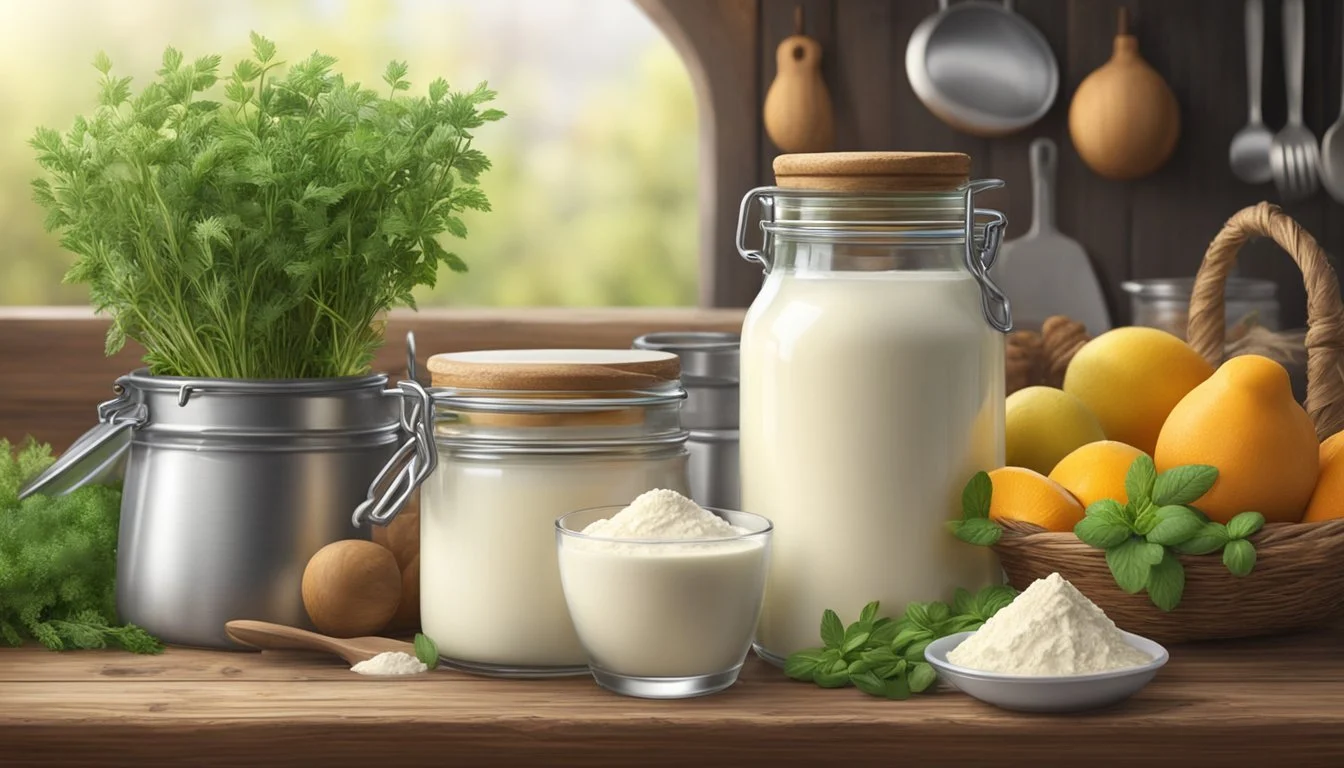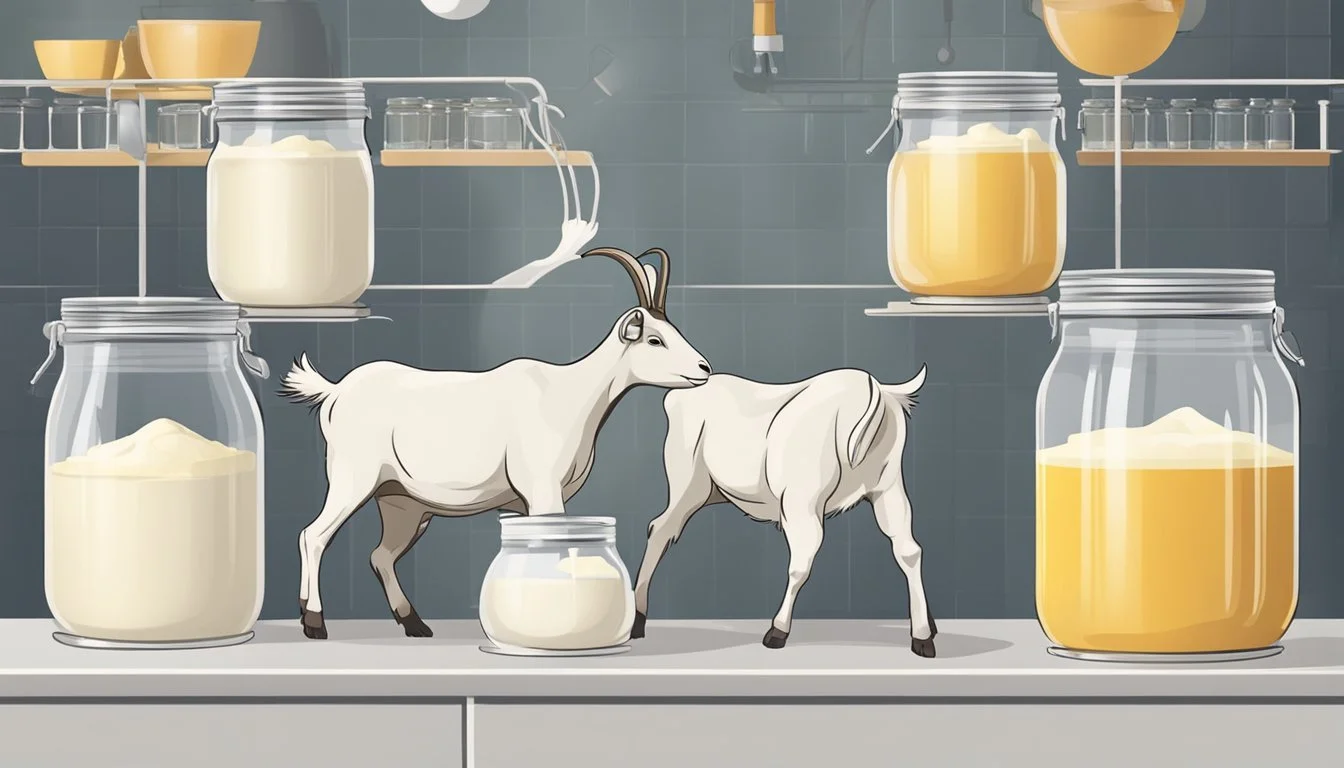Creative Ways to Use Goat Milk Whey
Elevate Your Cooking with This Nutritious Byproduct
Goat milk whey, often a byproduct of cheese-making, is a valuable ingredient with a myriad of uses in the kitchen. Rich in protein and minerals, whey from goat milk elevates the nutritional profile of many dishes while also reducing waste. This liquid treasure, which can range from tangy to sweet, adds a depth of flavor to recipes that water or other liquids simply cannot match.
Finding creative ways to incorporate goat milk whey into cooking and baking can be both a delightful adventure and a step towards more sustainable culinary practices. Whether it's used to tenderize meats, enrich baked goods, or add complexity to soups and sauces, the applications of goat milk whey are impressively diverse. Home cooks and professional chefs alike can benefit from its attributes, turning an overlooked byproduct into a cornerstone of flavor enhancement and nutrition.
With its unique properties, goat milk whey serves not only as a substitute for liquids in recipes but also affords health benefits, such as aiding digestion and providing essential amino acids. Its versatile nature allows for it to be a hidden hero in the kitchen, infusing meals with subtle notes that elevate the ordinary to extraordinary. Explore the ways this nutritious byproduct can transform your cooking, from the simplest of smoothies to the most elaborate of entrees.
Nutritional Benefits of Goat Milk Whey
Goat milk whey is not only versatile in culinary applications but also offers a broad spectrum of nutritional benefits. It is a rich source of quality protein, essential vitamins and minerals, probiotics, and is known for its digestibility.
Vitamins and Minerals Content
Goat milk whey contains a variety of vitamins and minerals that are essential for maintaining good health. It is particularly rich in important minerals like calcium, magnesium, and potassium. The presence of these minerals assists in bone development, regulating blood pressure, and supporting metabolic processes. Additionally, it provides a good source of vitamins such as vitamin B2 (riboflavin) and vitamin A, which aid in energy production and vision health, respectively.
Protein and Probiotics Boost
The protein content in goat milk whey is noteworthy, with whey protein being a complete protein containing all nine essential amino acids. The inclusion of goat whey in one’s diet can support muscle growth and repair, thanks to its high concentration of branched-chain amino acids (BCAAs), particularly leucine. Furthermore, goat milk whey also offers probiotics which are beneficial for gut health, supporting digestion, and reinforcing the immune system.
Lactose Content and Digestibility
Goat milk whey is lauded for its digestibility, making it a suitable option for many individuals who have difficulty digesting cow's milk whey. The lactose content in goat milk is lower and forms a softer curd in the stomach which can be easier to digest. This characteristic means that it may be better tolerated by those with lactose sensitivities, aiding in the digestion process without causing discomfort.
Creative Kitchen Recipes
Goat milk whey is a versatile ingredient that can enhance various recipes, from savory dishes to sweet baked goods. It offers a unique flavor profile and nutritional benefits that can be creatively incorporated into everyday cooking.
Goat Milk Whey in Baking
Baking with goat milk whey can add a tender crumb to breads and a rich, complex flavor to traditional baked goods. Home cooks can replace water with whey in their bread recipes for added protein, or they can follow a baking recipe that specifically calls for whey. Whey can also be used in place of milk in various recipes, by using a ratio of 50% whey to 50% milk or dairy alternative. Pancakes, waffles, muffins, biscuits, and cornbread are all excellent candidates for adding whey, which can contribute to a fluffy texture and a subtle tanginess.
Homemade Whey-Infused Smoothies and Drinks
In the realm of drinks, whey functions as a nutritious liquid base for smoothies. A fruit smoothie with goat milk whey offers a protein boost and can be complemented by adding vegetables like frozen cauliflower for additional nutrients. For instance, a smoothie recipe utilizing goat milk whey might include ingredients like pumpkin puree or peanut butter to create a satisfying and healthful drink. Substituting parts of the liquid in coffee beverages with whey can also impart a subtle creaminess and enhance the complexity of the flavor.
Savoury Dishes and Soups
Goat milk whey can be a secret weapon in savory dishes, providing a depth of flavor and tenderizing action in marinades. The enzymes in whey make it effective for marinating steaks, chicken, fish, or pork chops, (What wine goes well with pork chops?) enhancing both texture and taste. Chefs can incorporate whey into soups and stews as a partial substitute for broth, enriching the soup base with a hint of creaminess without the added fat. Opportunities exist to integrate whey in pasta dishes, perhaps in the liquid for cooking the pasta itself, or even to add a nuanced flavor to mashed potatoes without watering down the consistency. A use for whey is to soften the texture and add a new dimension to traditional soups and root vegetable dishes.
Whey in Dairy Product Fermentation
Goat milk whey, a byproduct of cheesemaking, contains beneficial bacteria and enzymes that are ideal for fermenting dairy products. Its use in fermentation can enrich flavor profiles and nutritional value, providing a sustainable approach to utilizing all components of goat milk.
Cheesemaking with Whey
Ricotta and mozzarella can be produced using leftover whey from previous cheesemaking processes. Specifically, ricotta is traditionally made by reheating the whey from cheese like mozzarella to produce a fresh, soft cheese rich in flavor. For mozzarella, a method known as "whey stretching" is employed, where curds are heated in hot whey to achieve the cheese's characteristic elasticity and texture.
Products: Ricotta, Mozzarella
Making Yogurt and Kefir
Cultures that thrive in whey can be introduced to pasteurized goat milk to create homemade yogurt and kefir. Whey serves as a starter culture, offering probiotics essential for the fermentation process. The resulting products boast a unique tang and are often smoother and richer than those made with conventional methods.
Products: Yogurt, Kefir
Preparing Cultured Butter and Buttermilk
Whey can be used to produce cultured dairy products like butter and buttermilk. For butter, the cream from goat milk is fermented with whey, enhancing the butter's flavor complexity. The byproduct of this butter churning is a whey-infused buttermilk that carries subtle tangy notes, which can be used in a variety of baking recipes.
Products: Butter, Buttermilk
Alternative Uses for Goat Milk Whey
Goat milk whey, a byproduct of cheese making, is a versatile ingredient that can enrich animal feeds, boost plant growth, and enhance beauty and skincare routines.
Animal Feed Enhancer
For animals on the homestead, goat milk whey serves as a nutritious supplement to their regular diet. Whey contains proteins and is packed with essential nutrients, which makes it an excellent feed additive. Chickens and pigs can particularly benefit from whey, as it aids in weight gain and enhances the overall quality of their eggs and meat. In addition, dogs may appreciate whey in their diet as a source of additional nutrition.
Natural Plant Fertilizer
Goat milk whey can be a valuable addition to plants by providing them with nutrients like potassium and phosphorous. A diluted solution of whey can be used as a natural fertilizer, aiding in the growth of vegetable gardens. It's also useful to soak beans and starter for lacto-fermenting vegetables, which can help improve the bioavailability of nutrients.
Beauty and Skincare Recipes
Homesteaders can utilize goat milk whey in beauty and skincare recipes. Whey's lactic acid content makes it a natural exfoliant and skin softener. It can be incorporated into homemade recipes for face wash, shampoo, and even soap, as it contributes to a silky and moisturizing texture. By adding whey to lotions and body washes, one can create beauty products that nourish the skin, leaving it smooth and refreshed.
Preservation and Storage Techniques
To ensure the longevity of goat milk whey, specific preservation methods such as freezing and dehydration are vital. These techniques not only extend the whey’s shelf life but also maintain its nutritional value for future culinary uses.
How to Freeze Goat Milk Whey
Freezing goat milk whey is straightforward. Begin by pouring the whey into ice cube trays or shallow freezer-safe containers, allowing some room at the top for expansion as it freezes. Once frozen, transfer the cubes to a sealed container or freezer bag, and label them with the date. Frozen whey can be used for up to 6 months, ensuring that one always has whey available for soups, smoothies, or sauces.
Extending Shelf Life via Dehydration
To dehydrate goat milk whey, first ensure it is fully strained and clear of curds. Spread the liquid thinly on dehydrator sheets or use a low-temperature oven if a dehydrator is not available. The drying process can take several hours. The end product should be a fine powder; this whey powder acts as a great nutritional supplement and can be easily reconstituted with water for various recipes. Store the powder in airtight containers to keep away moisture and use within 1 year for optimal quality.
Health and Dietary Considerations
When incorporating goat milk whey into one's diet, it is important to consider its impacts on health, including aspects such as lactose content and caloric value. These considerations help consumers make informed dietary choices in alignment with their health goals and needs.
Allergies and Intolerances
Lactose: Goat milk whey contains lactose, a sugar that some individuals find challenging to digest. While it is often more digestible than cow’s milk due to its different protein structure, those with lactose intolerances should still approach goat whey with caution.
Proteins: Some people may also experience sensitivities to specific proteins found in goat milk. Alpha S1 casein, a type of protein less prevalent in goat milk compared to cow milk, may trigger fewer allergic reactions, making goat milk whey a possible alternative for those with certain dairy allergies.
Caloric Content and Weight Management
Calories: The caloric content of goat milk whey is notable for those monitoring their energy intake. It is a concentrated source of nutrients and should be consumed within the parameters of a balanced diet.
Nutrient: Calories
Approximate Content in Goat Milk Whey: Variable, depending on processing
Nutrient: Carbohydrates
Approximate Content in Goat Milk Whey: Mostly in the form of lactose
Nutrient: Proteins
Approximate Content in Goat Milk Whey: Essential for muscle maintenance
Vitamins and Minerals: Goat milk whey provides a good source of various vitamins such as Vitamin A and is often enriched with Vitamin D. It also offers minerals like calcium and phosphorus, enhancing its nutritional profile for bone health.
In terms of weight management, goat milk whey can be integrated into a diet in a way that supports one's goals. Its protein content can promote satiety, which might help with weight control. However, moderation is key, as excessive intake could contribute to an increased caloric intake.
Crafting a Business with Goat Milk Whey
Goat milk whey offers a unique opportunity for homesteaders and small business owners to sell a range of nutritious dairy products. Let's explore the specific strategies and tips to successfully market and sell whey-based products.
Selling Whey-Based Products
Product Creation: Entrepreneurs can capitalize on the health benefits of goat milk whey by developing an assortment of whey-based products. This can include items like whey beverages, protein supplements, and whey-enriched baked goods. The key is to create recipes that highlight whey's nutritional profile, such as using it as a substitute for water or milk in baked goods, as suggested by Goat Milk Stuff.
Regulatory Compliance: To sell dairy products, it's essential to comply with food safety regulations. This means maintaining a clean production environment, labeling products accurately, and possibly acquiring certifications, depending on local laws.
Marketing Tips for Home Producers
Online Presence: A digital storefront and social media presence are instrumental in reaching a wide customer base. Producers should craft a story around their homestead and use high-quality images of their products to build an online brand.
Target Audience: Identify and understand the target market, which may consist of health-conscious individuals, fitness enthusiasts, or those with a passion for artisanal foods. Tailor marketing messages to these groups and highlight the unique selling points, such as the artisanal nature of the whey products or the sustainability of the production methods.
By employing these strategies, producers can confidently build their business around goat milk whey, offering quality products to a growing niche market.







